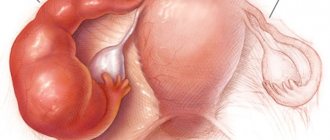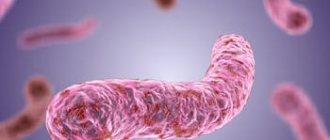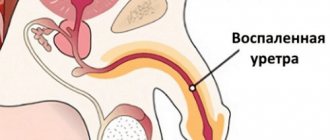Norovirus is a pathogenic bacterium that acts as a provocateur of an intestinal infection, which in the medical field is known as intestinal flu. This disease is diagnosed regardless of gender and age.
- Etiology
- Symptoms
- Diagnostics
- Treatment
- Prevention and prognosis
The infectious process develops only after the penetration of a pathological agent into the human body. Infectious disease specialists know several mechanisms of infection of healthy people.
Since the intestines are affected during the course of the disease, the main symptoms will be nonspecific, since they resemble the course of a large number of gastrointestinal diseases. The main clinical manifestations are considered to be stool upset, cutting pain in the abdomen, attacks of nausea and vomiting, as well as general malaise and loss of appetite.
The diagnostic process involves the implementation of a whole complex of laboratory and instrumental examinations. Not the least important role in establishing the correct diagnosis is also occupied by the activities performed by an infectious disease specialist.
Methods for treating norovirus and the infection caused by it are conservative in nature, and the basis is taking medications.
Etiology
Norovirus is not a specific bacterium, but a whole group of microorganisms, numbering about 25 different strains. The bacillus that causes gastrointestinal diseases is highly contagious, i.e. infectiousness, as well as resistance to environmental conditions, where it remains viable for a long time.
In the vast majority of situations, norovirus intestinal infection is diagnosed between November and March, however, this does not mean that the incidence is not observed at other times of the year.
It is also worth noting that there are currently 7 genotypes of the virus known, but only 3 of them are dangerous to humans. It is noteworthy that in approximately 90% of cases, norovirus genotype 2 acts as a provocateur of the disease.
This pathological agent is transmitted in only 3 ways:
- food - realized in the process of eating unwashed vegetables, berries and fruits;
- waterborne – infection occurs when accidentally entering or drinking contaminated water;
- household contact is the most common mechanism of transmission of pathogenic microorganisms. It is carried out in the absence of the habit of washing hands after going outside, using poorly washed dishes, or coming into contact with household items touched by an infected person.
A patient who has norovirus in his body will be contagious from the moment the bacillus penetrates, throughout the entire period of the disease, and for about another 3 days from the moment all clinical manifestations stop.
Newcomer among infections
Image from thedailybeast.com
Summer is the season of acute intestinal diseases, and at this time all popular resources write about them. And they write about everything. Listeria, Escherichia, salmonella, dysentery - we know this enemy by sight and are ready to meet it fully armed. We’ve also heard about rotavirus and enterovirus, not to mention good old cholera, but this is the first time we’ve encountered norovirus.
Are you, reader, ready for the harsh truth?
This pathogen came to us from America.
...In November 1968, in the distant city of Norwalk, Ohio, an outbreak of acute gastroenteritis was reported among students at an unremarkable elementary school. Unable to immediately determine which infection caused the disease, doctors preserved fecal samples from patients.
In 1972, preserved samples were subjected to immunoelectron microscopy, and finally, scientists isolated a new virus, which was named Norwalk (aka Norfolk).
The genus name Norovirus was approved by the International Committee on Taxonomy of Viruses in 2002. Since then, numerous outbreaks of disease caused by this pathogen have been reported worldwide.
Interestingly, not everyone is equally susceptible to norovirus infection: for unknown reasons, people with the first blood group get sick more often, but the third and fourth groups are less susceptible to the pathogen.
A person who has recovered from the disease develops immunity, but for a very short period of time, not to mention the fact that there are about 25 types of norovirus, and immunity to one does not protect against infection by another. The US Centers for Disease Control estimates that every citizen in this country will experience norovirus infection five times during their lifetime, and each time their illness will be caused by a different type of virus.
Symptoms
Since norovirus intestinal infection is provoked by the influence of a pathogenic bacterium, it is advisable to note the incubation period, which in this case lasts from 1 to 3 days.
The first clinical signs of norovirus gastroenteritis are considered to be:
- sudden onset of nausea;
- persistent and intense vomiting;
- watery consistency of stool.
In people with weakened immune systems, children and women during pregnancy, at the beginning of the disease, the following is also noted:
- increase in temperature above 38 degrees;
- attacks of headache;
- constant drowsiness;
- cutting pain in the abdominal area;
- decreased appetite;
- sore throat;
- nasal congestion;
- increased tearfulness;
- severe stomach colic;
- pain in the upper and lower extremities.
If treatment of the disease was started at this stage of its course, then complete recovery occurs in about a few days. However, in the absence of qualified assistance, there is a high probability of signs of progressive dehydration in adults and children, which is caused by fluid loss due to frequent vomiting and diarrhea. In such situations, the symptoms will be presented:
- thirst;
- dizziness;
- causeless fatigue;
- dry mouth, despite ingestion of liquid;
- darkening of urine;
- dry lips and mucous eyes;
- rare urge to empty the bladder, namely, less than 3 times a day.
In order to get rid of such signs, you need to drink plenty of water, however, if you do not replenish lost fluid, the following symptoms of norovirus infection may appear:
- dry skin;
- complete absence of urine;
- sunken eyes;
- general malaise;
- increased heart rate;
- fluctuations in blood tone;
- weak pulse;
- attacks of loss of consciousness;
- increased irritability;
- decrease in local temperature of the upper and lower extremities.
Norovirus
If such clinical manifestations occur, the victim must be given first aid, the rules of which include:
- the patient adopts a horizontal body position - the person must be laid on his side so that he does not choke on his own vomit;
- frequent ventilation of the room in which the patient is located;
- washing the stomach with a weak solution of potassium permanganate - this will not only relieve a person from severe vomiting, but will also remove most of the pathogenic microflora and waste products of bacilli from the body;
- performing a cleansing enema - often using slightly salted water or rehydron solution for this;
- providing the patient with plenty of fluids - liquid should be given often, but always in small portions. Permitted drinks are purified water without gas, fruit drinks, compotes or green tea;
- intake of absorbents.
If the patient’s condition has not improved, then you should immediately call a medical team at home, this is especially necessary in cases of infection during pregnancy, in children or the elderly.
Epidemiology, incubation period
The source of infection is always a sick person and an asymptomatic (latent) virus carrier . The dose sufficient for infection is very small; only 10 viral particles are enough. Each patient is capable of causing a small local epidemic, infecting up to 14 people with gastroenteritis.
A person who has contracted the infection releases the pathogen into the external environment along with biological waste - feces, vomit, sputum. The released agent spreads at lightning speed from person to person. Through surfaces with which the pathology carrier came into contact - door handles, table surfaces, etc.
The virus attaches to the cells of the digestive tract, enters the mucous membrane of the small intestine, infecting the cells of the villous epithelium, and then very quickly affects the large intestine. Then it begins to multiply by replicating (copying) RNA, thereby destroying the villi of the epithelium and causing a decrease in the absorption of water and sodium salts from the intestinal lumen.
Incubation period
The incubation, latent period of infection can last from several hours to 2–5 days. Peak virus shedding occurs 1-2 days after infection. But it can continue after the clinical picture disappears for 5 to 48 days, usually up to 28.
In patients with immunodeficiency, this period extends to 120–180 days. In patients with chronic diarrhea, cases of virus shedding have been recorded for up to 2 years. People with asymptomatic infection are able to shed viruses for more than 3 weeks after infection.
Immunity
Infection with noroviruses is accompanied by the appearance of antibodies to the pathogen, which form a short-term immune response of up to 8 weeks and prevent re-infection. In 15% of the population, genetic immunity to noroviruses occurs, and in 13% the infection is asymptomatic. There is no vaccine for norovirus yet. It is under active development.
Diagnostics
From the symptoms described above, it follows that the clinical picture of norovirus infection is nonspecific, i.e. Based only on such signs it is impossible to make a correct diagnosis.
It is for this reason that the diagnostic process includes a wide range of laboratory and instrumental examinations, before conducting which an infectious disease specialist or gastroenterologist must:
- study the medical history - to identify concomitant diseases that may affect the severe course of this disease;
- get acquainted with the person’s life history - this is necessary to determine the route of transmission of norovirus;
- carefully examine the patient and palpate the anterior wall of the abdominal cavity;
- assess the appearance, condition of the victim’s skin and mucous membranes;
- measure temperature and pulse readings, heart rate and blood pressure;
- interview the patient in detail to determine the first time of onset and severity of symptoms.
Among the laboratory tests it is worth highlighting:
- general clinical analysis of blood and urine;
- blood biochemistry;
- microscopic examination of feces;
- culture of vomit;
- PCR tests;
- serological tests.
Instrumental procedures are aimed at:
- radiography;
- fibrogastroscopy;
- ultrasonography;
- ECG;
- CT and MRI.
Ultrasonography of the stomach
Norovirus infection is differentiated from a wide range of other gastrointestinal diseases of a viral nature.
Detection of norovirus in food
Routine reverse transcriptase polymerase chain reaction (RTPCR) tests for the detection of norovirus (RNA virus) in edible shellfish and oysters are required by government laboratories such as the FDA in the United States.
However, standard methods for determining the presence of the virus in food are not always readily available due to the heterogeneous origin of different products, which affects the concentration and extraction of the virus, and the presence of factors that make PCR (polymerase chain reaction) analysis methods ineffective.[25]
Routine reverse transcriptase polymerase chain reaction (RTPCR) testing for Norwalk virus (RNA virus) in edible shellfish and oysters is requested by government laboratories such as the FDA in the United States.
However, standard methods for determining the presence of the virus in food are not always acceptable due to the heterogeneous origin of different products, which affects the concentration and extraction of the virus, and the presence of factors that make PCR (polymerase chain reaction) analysis methods ineffective[30].
Treatment
To stabilize the patient's condition, the following conservative techniques are used:
- intravenous administration of saline or glucose - this is necessary to restore water balance;
- taking general strengthening agents and vitamin complexes;
- use of antibacterial and antimicrobial drugs;
- use of antiemetic and antipyretic drugs.
Diet therapy, which has a number of rules, is of great importance in the treatment of norovirus infection:
- refusal to consume raw vegetables and fruits;
- complete exclusion from the diet of fatty, spicy and salty foods, as well as those foods that increase intestinal motility;
- enriching the menu with fermented milk products with a low fat content;
- cooking food only using gentle methods, namely by boiling and stewing, baking and steaming;
- fractional meals, but the number of meals can reach 6 times a day;
- thorough grinding and chewing of food;
- control over the temperature of food;
- drinking plenty of fluids.
A complete list of recommendations regarding diet can only be provided by the attending physician, based on the severity of the disease and the age category of the patient.
The use of traditional medicine recipes in this case is prohibited, since this can only aggravate the situation.
How to treat intestinal flu?
Rotovirus infection affects the intestines and completely kills beneficial microorganisms, causing the above symptoms.
Therefore, the treatment of intestinal flu should be taken very seriously. In this post, I describe my experience in treating this disease. In no way do I advocate treating rotavirus the way I do. At the first suspicion, be sure to consult a doctor who will give you an accurate diagnosis and prescribe treatment. So, my task was to stop the child's diarrhea and replenish the fluid in his body. To do this, I used Smecta (it stops diarrhea and removes all the bad stuff from the body) and saline solution. I bought it at the pharmacy, it is sold under the name Regidron. Thanks to it, fluid loss is stopped or minimized. I also brewed and gave my daughter a chamomile infusion. I added a little honey to it. She drank this drink with pleasure.
As a result of the treatment, the diarrhea and fever went away in about 3 days, I felt relieved that all my efforts had not gone to waste, which I was incredibly happy about. But the disease did not completely recede. Be sure to follow a diet during and after illness. Eliminate dairy completely. Give only light foods (broths, soups), plenty of water and liquid.
Do not give chips, soda and all other chemicals! At the same time, I gave medications that restored the intestinal microflora. In my case it was Linux. Since the virus lives on average for seven days, the intestinal flu torments a person for about the same time. Next comes a long recovery period. I’ll say right away that you shouldn’t rely on antibiotics. They will not help against norovirus, and will further undermine the immune system.
Read about how I treat ARVI here.
Prevention and prognosis
To date, no specific vaccine has been developed against norovirus. It follows from this that preventive measures will be of a general nature, i.e. include the following recommendations:
- compliance with individual hygiene standards and rules;
- maintaining a healthy and active lifestyle;
- drinking only purified water;
- washing fruits and vegetables before eating;
- avoiding contact with an infected person, as well as objects and things that he touched;
- undergo a full preventive examination at a medical facility several times a year.
The prognosis for norovirus intestinal infection in the vast majority of situations is favorable - after a person suffers such an illness, he develops an unstable immunity that lasts about 2 months, after which he will again be susceptible to the pathological influence of norovirus. In extremely rare cases, the disease leads to death - this is due to severe dehydration.
Routes of infection
- Do not visit public places;
- Don't cook for other people;
- Disinfect the sanitary facility after each use;
- Use separate personal hygiene items (towel, cutlery).
People of any age can catch norovirus. Typically, the disease is transmitted by the fecal-oral route, that is, through contaminated food and/or contact with a sick person. It should be noted that immunity is practically not developed after an illness, but is rather temporary.
In addition, it has been proven that there is an innate tendency to infections caused by noroviruses. Thus, people with blood group 1 are susceptible to viral gastroenteritis much more often (every second patient has this particular group). Patients with groups 3 and 4 are “luckier”: they have partial immunity.
“Gastrointestinal epidemics” usually occur in closed or semi-closed institutions (health care facilities, dormitories, kindergartens). Under such conditions, the virus quickly spreads from a sick person to a healthy person. The virus is also often transmitted through food if the patient has had any contact with it.
The source of infection is only humans. This may be a patient with severe clinical symptoms, subsiding symptoms of the disease, or with minimal changes in general condition (subclinical form). A feature of such patients is the possibility of prolonged (up to 1 month) release of norovirus into the environment. Thus, favorable conditions are created for the spread and circulation of the virus in the environment.
We recommend reading:
Methods of rehydrating the body for dehydration: oral and parenteral agents
From the point of view of possible infection, the following situations are dangerous:
- drinking unboiled water, as well as ice cubes in drinks;
- drinking contaminated water from unverified sources;
- direct contact with a sick person or staying in the same room (norovirus cells from vomit or feces can become airborne);
- consumption of thermally unprocessed food (seafood, green salad leaves, ice cream and other dairy dishes are especially dangerous).
Norovirus is highly contagious and affects people of all ages. Typical is the mass incidence of people who are in a limited area: a hotel, a cruise ship, hospitals and closed medical institutions, ordinary dormitories, prison cells.
Young children and elderly people with chronic diseases are almost 100% susceptible to norovirus. Immunity after an illness is unstable, and cases of re-infection are possible.
Norovirus infection occurs everywhere; residents of developing and socially prosperous countries are equally likely to be infected.
Symptoms of pathology
The symptoms of the disease and treatment of norovirus in children are almost no different from adults. A characteristic feature is the severity of the onset, the strength of manifestation and the predominance of vomiting (in adults, diarrhea occurs first and is more pronounced). Vomiting is the first thing that occurs in children. At an early age (up to a year) it occurs multiple times at once. Complemented by fever (temperature up to 40 degrees), weakness and tearfulness, refusal to eat, sweating.
Symptoms of norovirus in older children are similar to adults: nausea, vomiting, diarrhea (up to 14 times), pain and cramps in the abdomen or other muscle areas, fever, cephalalgia. Symptoms of dehydration gradually increase: dry skin and nasopharynx, constant thirst, weakness, rare urination, loss of appetite.
In adolescents and adults, the disease often begins unobtrusively and is similar to the flu: fever, sore throat, runny nose, cough, weakness. Later, intestinal signs appear.
In children, vomiting is the main symptom of infection.
If there are signs of dehydration, it is important to take timely restorative measures or go to the hospital. It is dehydration, and not the norovirus itself, that causes the majority of deaths.
There is a symptomatic complex that requires immediate medical attention. It includes diarrhea and vomiting up to 10-20 times a day, splashes of blood or black discharge, rashes with red spots up to 50 mm, acute cutting pain in the stomach and (or) intestines. The incubation period of norovirus ranges from several hours to three days. Symptoms last on average up to four days.
Disease Prevention
Any disease is always more difficult and costly to treat than to prevent, especially when it comes to severe cases. There is no vaccine for norovirus, but despite the fact that these bacilli are resistant to many external factors and remain active for a long time, preventive measures are basic. To avoid getting an intestinal infection, you need to follow these rules:
- Wash your hands frequently with soap throughout the day . Especially after going to the toilet, walking outside or playing with pets.
- Buy food only in designated places. Sometimes a ruble saved on vegetables or fruits costs health and nerves.
- All plant products are washed well with running water and then doused with boiling water. Under the influence of high temperatures, many pathogens die.
- Drink only boiled water or water intended for direct consumption.
- Whenever possible, food products should be subjected to heat treatment.
- Maintain cleanliness and order in the kitchen. Cutting boards should be separate for different types of products - meat, fish, vegetables, fruits and bread.
Dishcloths and sponges are changed every few days. It is important to remember that this is the main breeding ground for infection. Microbes from kitchen rags end up on dishes and then into the human body.
Any intestinal infection is very unpleasant, but there is no need to panic. First, you need to objectively assess the severity of the patient’s condition, provide him with first aid and, if necessary, call a doctor. If proper treatment is started on time, the disease disappears without a trace in just a few days.






